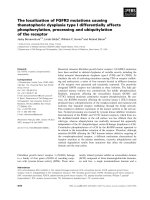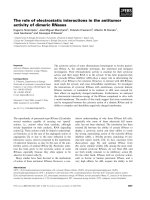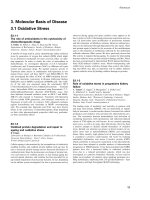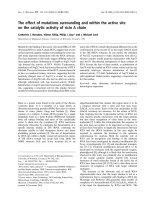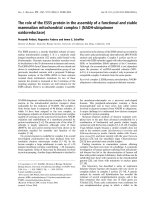báo cáo khoa học: " The impact of hyperbaric oxygen therapy on serological values of vascular endothelial growth factor (VEGF) and basic fibroblast growth factor (bFGF)" pptx
Bạn đang xem bản rút gọn của tài liệu. Xem và tải ngay bản đầy đủ của tài liệu tại đây (370.5 KB, 5 trang )
RESEARC H Open Access
The impact of hyperbaric oxygen therapy on
serological values of vascular endothelial
growth factor (VEGF) and basic fibroblast
growth factor (bFGF)
Susanne Jung
1
, Kai Wermker
1
, Harald Poetschik
2
, Thomas Ziebura
3
, Johannes Kleinheinz
1*
Abstract
Background: Hyperbaric oxygen (HBO) therapy is an effective adjunct treatment for ischemic disorders such as
chronic infection or chronic wounds. It combines hyperoxic effects with the stimulating potential of post-
therapeutic reactive hypoxia. As its crucial effects, stimulation of fibroblast growth, induction of collagen synthesis
and the initiation of angiogenesis are discussed. Angiogen esis is a multistage process resulting in the growth of
blood ve ssels. It includes degradation of extracellular matrix, proliferation and migration of different cell
populations and finally formation of new vessel structures. This complex chain of procedures is orchestrated by
different cytokines and growth factors. Crucial mediators of angiogenesis are basic fibroblast growth factor (bFGF)
and vascular endothelial growth factor (VEGF); their in-vivo function is still not fully understood.
Methods: Forty-three patients suffering from sudden sensorineural hearing loss or tinnitus were treated with HBO.
The therapy included 10 sessions of 90 minutes each, one session a day. Serological levels of bFGF and VEGF were
assessed by enzyme-linked immunosorbent assays performed according to the manufacturer’s instructions on day
1, 2, 5 and 10 of HBO therapy and were compared to mean values of the control group, related to the patient’s
age and sex, and their development observed over the ten days of HBO.
Results: There was no sex- or age dependency of bFGF observed in the present study, whereas under HBO our
results showed a significant mitigation of the bFGF concentration. In the present data, there was no connection
between the VEGF concentration and the patients’ ages. Women showed significantly higher levels of VEGF. There
was no significant change of VEGF concentration or the VEGF/bFGF ratio during HBO. All scored results varied
within the range of standard values as described in the current literature.
Conclusions: A significant effect of HBO on serum concentrations of bFGF and VEGF was not verified in the
present study. Additional application of exogenous growth factors in conjunction with HBO was not obviously
linked by a coherent cause-and-effect chain as far as wound healing is concerned.
Background
Therapeutic administration of HBO was first mentioned
in 1873 when miners were treated for decompression
sickness [1]. Today, hyperbaric oxygen therapy is an
effective treatment modality in the management of a
variety of disorders, such as severe anaemia, gas
gangrene, arterial gas embolism, carbon monoxide poi-
soning, radiation injuries, necrotizing infections, refrac-
tory wounds and chronic osteomyelitis but also acute
ischemic disorders like acute se nsorineural hearing loss
or ischemic stroke [2].
Hyperbaric oxygen therapy involves the intermittent
inhalation of 100% oxygen in chambers pressurized
between 1.5 and 3.0 atmosphere absolute (ATA). An
ATA is defined as the atmospheric pressure at sea level
and is equivalent to 101.3 kilopascals or about 14.7
* Correspondence:
1
Department of Cranio-Maxillofacial Surgery, Research Unit Vascular Biology
of Oral Structures (VABOS), University Hospital Muenster, Waldeyerstrasse 30,
D-48149 Muenster, Germany
Full list of author information is available at the end of the article
Jung et al. Head & Face Medicine 2010, 6:29
/>HEAD & FACE MEDICINE
© 2010 J ung et al; licensee BioMed Central Ltd. This is an Open Access article distributed under the terms of the Creative Commons
Attribution Lice nse ( which permits unrestricted use, distribution, and reproduction in
any medium, provided the original work is prop erly cited.
pounds per square inch. Its immediate effect is to
increase dissolved oxygen content to above physiologic
levels according to Krogh Erlang mechanism [3]. The
benefit of H BO is based on the premise that raising tis-
sue oxygen levels will enhance wound healing ability.
The ignition for healing p rocesses and angiogenesis is
the lack of oxygen, but a sufficient oxygen supply is t he
basis for all proliferation or healing activities.
The positive effects of hyperoxia basically are
- vasoconstriction of arterioles, reduction of oedema
- bactericidal impact on anaerobial microbes and
toxin-deactivation
- mobilisation and activation of leucocytes and
macrophages
- activation of fibroblasts’ collagen release
- activation of osteoclasts and stimulation of
osteogensis
- cover of raised oxygen requirement of the damaged
tissue in spite of impaired blood supply via stimulation
of angiogenesis [4,5].
A final destination of all sorts of repair process is the
re-establishment of a sufficient perfusion and oxygen
supply. The present study focuses on the relevant med-
iators of angiogenesis which are vascular endothelial
growth factor (VEGF) and basic growth factor (bFGF).
In angiogenesis, a number of growth factors (for exam-
ple Angiopoietin-1, Platelet derived growth factor,
Hypoxia inducing factor-1a, EphrinB2, Nitric Oxygen
Synthase) have been found to play significant roles;
VEGF and bFGF are the most extensively investigated
angiogenic factors to date [6,7].
AsasinglepolypeptidebFGFisproducedbyavari-
ety of cell populations, mainly by activated macro-
phages and thrombocytes. It belongs to one of the 22
members of the FGF family and transmits its signals
via tyrosine kinase receptors [8,9]. Due to its ability to
stimulate the activity of fibroblasts, endothelial cells,
smooth muscle cells and neurons, bFGF is involved in
many physiological and pathophysiological processes
like growth, wound and bone healing, cell differentia-
tion and proliferation, but also tumour progression
and metastasis [10,11]. The key ability of bFGF is to
induce angiogenesis via stimulation of VEGF expres-
sion, the effectiveness of a combined application is
therefore easily explained. It is mitogenic on fibroblasts
and endothelial cells [12].
VEGF is homodimer glycoprotein, its family includes 6
related proteins; VEGF 165 is most common and biolo-
gically active [13]. It is released by many cell populations
as fibroblasts, monocytes, macrophages or lymphocytes
[14]. The corresponding receptors belong to the tyrosine
kinase family. VEGF induces angiogenesis on different
levels: it acts as mitogen especially on endothelial cells,
raises the vessel permeability and dilatation by releasing
NO and has chemotactic impact on other growth pro-
moting cell populations [15].
Under hypoxia an increase of VEGF mRNA could be
shown, and in addition to that the RNA’s half-life was
extended. This effect is translated by the hypoxia sensitive
transcription factor HIF-1. The instantaneous angiogenic
effect of VEGF is the increase in vessel permeability
and mitogenic stimulation of endothelial cells. According
to its potential, VEGF is also involved in pathophysiologi-
cal processes like tumour growth; mainly in hypoxic
tumour regions raised VEGF levels could be scored
[16,17].
The idea o f the present study was to characterize and
to quantify the effect of HBO on the expression of the
growth factors bFGF a nd VEGF and, hence, to explain
the mechanism of its therapeutic use.
Methods
Between May and October 1999, specimens were
obtained from 86 persons: 43 patients and 43 control
subjects (Table 1). In the HBO group, 43 patients trea-
ted for acute hearing loss or tinnitus were enrolled. Dur-
ing 10 days, they received HBO for 90 minutes each day,
the applied pressure was 1.55 bar.
Blood samples of 7.5 ml of perip heral blood were taken
on day 1, 2, 5 and 10 of HBO treatment, after examina-
tion and informed consent of the control persons using
standard serum test tubes, respectively; samples were
stored at 2-5°C, centrifuged (1000/min) after a 60-minute
period of coagulation and stored at -80°C until analysis.
VEGF concentrations were assessed b y performing a solid-
phase V EGF Immunoassay ( VEGF Quantikine, DVE00, R&D
Systems GmbH, Wiesbaden-Nordenstadt, Germany R&D
Systems). T he ELISA was performed according to the manu-
facturer’s protocol; its sensitivity was described as < 25 pg/
ml. The concentration of VEGF was expressed as pg/ml.
VEGF was quantified by using a standard curve made by
human VEGF ranging from 62 pg/ml to 707 pg/ml. The
chromogenic reaction w as read at 450 nm.
The bFGF concentrations were assessed by performing
a solid-phase bFGF Immunoassay (FGF basic Quanti-
kine, HSFB50, R&D Systems GmbH, Wiesbaden-Nor-
denstadt, Germany R&D Systems). The ELISA was
performed according to the manufacturer’s protocol; its
sensitivity was described as < 5 pg/ml. The concentra-
tion of bFGF was expressed as pg/ml. The bFGF was
quantifiedbyusingastandardcurvemadebyhuman
bFGF ranging from 0 pg/ml to 4.40 pg/ml. The chromo-
genic reaction was read at 490 nm.
Evaluated parameters
The evaluation focused on the most important angio-
genic factors VEGF and bFGF and their serological
values (Table 2) [18,19].
Jung et al. Head & Face Medicine 2010, 6:29
/>Page 2 of 5
Statistical analysis
The results are expressed as mean values +/- standard
deviations (SD) for each group. Normal curve of distri-
bution of results, means and SD were controlled with
the David, Pearson and Stephens test. Data were statisti-
cally analyzed by using the analysis of variance
(ANOVA) and Scheffe test. Differences between groups
were assessed using the Whitney Man n U-test. An error
probability of p < 0.05 was adopted as the statistically
significant level.
Results
bFGF
There was no significant difference in bFGF concentra-
tion between HBO and control group before HBO.
There was no sex- or age dependency according to our
results. In the present study, under HBO a significant
mitigation of the bFGF concentration within standard-
values could be observed (Table 3). Diff erences between
bFGF concentrations at day 1 and day 10 within the
HBO group reached statistical significance (p = 0.041).
VEGF
There w as a significant difference in VEGF concentra-
tion between patients and contro l group before HBO (p
= 0.015). In our results there was no connection
between the VEGF concentration and the patien ts’ ages.
Women showed significantly higher levels of VEGF
(279.65 +/- 243 .70 pg/ml) compared to male subjects
(193.58 +/- 162.39 pg/ml) (p = 0.026). There was no sig-
nificant change of VEGF conce ntration under HBO
(Table 4).
VEGF/bFGF ratio
Although a slight increase of the ratio could be docu-
mented, there was no significant variance of the VEGF/
bFGF ratio in the present study (Figure 1).
Discussion
Under HBO therapy a significant reduction of bFGF was
detected. The concentration of VE GF did not change
but was measured significantly higher in female test per-
sons. All collected results were within the range of stan-
dard values according to the current literature.
The influence of the ischemic inner-ear disorder for
which the HBO group was treated could not be fully
excluded as an interfering factor. Yet it seemed highly
implausible because so far only grave diseases have been
reported to affect bFGF and VEGF concentration [20].
There are several explanations for the reduced bFGF
level under HBO. One hypothesis states that there are
simply more bFGF molecules binding on their receptor
and transmitting their signal. These molecules are no
longer detectable for the performed assays.
There might be a higher rate of binding on circulation
proteins in the course of repair processes: these ligand-
receptor complexes are possibly the activating agen ts
indu cing fibroblast proliferatio n, collagen release, osteo-
and angioneogenesis.
Eventually, a therapy period of ten days was ob served.
Possibly, there was a delayed cellular adaptation to the
HBO treatment, where protective cell populations have
to be activated for repair mechanisms to oxygen free-
radical d amage. There are hints in literature that effec-
tive cellular responses to HBO cannot be expected
before day seven of treatment [21].
Another consideration is that acute sensoneurinal
hearing loss and tinnitus do not require the induction of
wound healing algor ithm to a comparable extend as tis-
sue lesions or chronic infe ctions do. S o the restraint
reaction of bFGF and VEGF in our dat a might be
explained.
Table 1 Patient data
n sex age average SD diagnosis
HBO group 43 22 ♂,21♀ 16-62 years 43.3 years 11.4 years 28 acute hearing loss
15 tinnitus
Control group 43 19 ♂,24♀ 18-65 years 29.9 years 14.1 years -
Distribution of sex and age in the study and the control group (SD = standard deviation)
Table 2 Characteristics of bFGF and VEGF
gene weight receptor synthesis standard value
pg/ml
bFGF 5p12-
p13
18 kDa tyrosine
kinase
macrophages 2.45
VEGF 6p12-
p21
39-45
kDa
tyrosine
kinase
fibroblasts 224
Characteristics of bFGF and VEGF
Table 3 Serological values of bFGF
bFGF in pg/ml
mean SD
Control group 2.65 3.01
HBO group - day 1 3.25 2.38
day 2 2.80 1.94
day 5 2.55 1.72
day 10 2.12 1.23
Serological values of bFGF in the study and the control group at definite
times
Jung et al. Head & Face Medicine 2010, 6:29
/>Page 3 of 5
The observed higher levels of VEGF in females find
their explication in their cycle-dependent hormone
regulation.
As far as VEGF c oncentration during HBO is con-
cerned our data suggests that the reactive hypoxia was
not enough of a stimulus for increased VEGF release.
Yet in-vivo and in-vitro studies have underlined the f act
that hypoxia is a potent stimul us for VEGF release [22].
In malignantly trans formed tissues the highest rates of
VEGF were found in hypoxic, necrotic areas [23].
Application of recombinant human VEGF showed
promising results in animal studies by promoting collat-
eral formation i n occluded vessels or proliferation of
endothelial cells in severed arteries [24].
A not yet mentioned field of interest dealing with
VEGF lies in tumour diagnosis and follow-up care.
VEGF might be able to act as an indicator of tumour
neo angiogenesis for elevated VEGF levels are observed
and even correlate with the tumour mass in patients
with malignant melanoma [25].
Some tumour entities as sarcomas are not accompa-
nied by elevated tumour markers like PSA in prostate
cancer [26,27]. As soon as VEGF’ s role in tumour
growth, in metastasis and, in particular, tumour neo-
angiogenesis will be furtherelucidated,VEGFserum
level and its development during the etiopathology
might become valuable prognostic tools [28,29].
Conclusions
Although in the present data a s ignificant effect of HBO o n
serum concentrations of bFGF and VEGF was not verified,
many studies revealed that intermittent HBO exposure
plays a direct role in vascular growth; the biochemical pro-
cesses, however, have not been fully understood. Additional
application of exogenous growth factors in conjunction
with HBO was not obviously linked by a coherent cause-
and-effect chain as f ar as wound healing is concerned.
Author details
1
Department of Cranio-Maxillofacial Surgery, Research Unit Vascular Biology
of Oral Structures (VABOS), University Hospital Muenster, Waldeyerstrasse 30,
D-48149 Muenster, Germany.
2
Private practice, Lueneburg, Germany.
3
Department of Orthodontics, University Hospital Muenster, Germany.
Authors’ contributions
SJ carried out the immunoassays and drafted the manuscript, KW and SJ
participated in the design of the study and performed the statistical analysis.
HP and JK conceived of the study, and participated in its design and
coordination and helped to draft the manuscript. HP and TZ were involved
in revising the article and all authors read and approved the final
manuscript.
Competing interests
The authors declare that they have no competing interests.
Received: 1 June 2010 Accepted: 22 December 2010
Published: 22 December 2010
References
1. Jacobson JH, Morsch JCH, Rendell-Baker L: The historical perspective of
hyperbaric therapy. Ann N Y Acad Sci 1965, 117:651-670.
2. Camporesi RM: Hyperbaric oxygen therapy: A Committee Report.
Undersea and Hyperbaric Medical Society Kensington MD USA; 1996.
3. Kindwall EP, Whelan HT: Hyperbaric medicine practice Flagstaff: Best
Publishing Company; 2008.
4. Hunt TK, Pai MP: The effect of varying ambient oxygen tensions on
wound metabolism and collagen synthesis. Surg Gynecol Obstet 1979,
135:561-7.
5. Siddiqui A, Galiano RD, Connors D, Gruskin E, Wu L, Mustoe TA: Differential
effects of oxygen on human dermal fibroblasts: acute versus chronic
hypoxia. Wound Repair Regen 1996, 4:211-8.
6. Ferrara N, Davis-Smyth T: The biology of vascular endothelial growth
factor. Endocrine Rev 1997, 18:4-25.
7. Inui K, Maeda M, Sano A, Fujioka K, Yutani Y, Sakawa A, Yamano Y, Kato Y,
Koike T: Local application of basic fibroblast growth factor minipellet
induces the healing of segmental bony defects in rabbits. Calcif Tissue Int
1998, 63:490-5.
8. Folkman J, Klagsbrun M, Sasse J, Wadzinski M, Ingber D, Vlodavsky I: A
heparin-binding angiogenic protein–basic fibroblast growth factor–is
stored within basement membrane. Am J Pathol 1988, 130:393-400.
9. Robson MC, Phillips LG, Lawrence WT, Bishop JB, Youngerman JS,
Hayward PG, Broemeling LD, Heggers JP: The safety and effect of topically
applied recombinant basic fibroblast growth factor on the healing of
chronic pressure sores. Ann Surg 1992, 216:401-6.
10. Brattström D, Bergqvist M, Larsson A, Holmertz J, Hesselius P, Rosenberg L,
Brodin O, Wagenius G: Basic fibroblast growth factor and vascular
endothelial growth factor in sera from non-small cell lung cancer
patients. Anticancer Res 1998, 18:1123-7.
11. Dellacono FR, Spiro J, Eisma R, Kreutzer D: Expression of basic fibroblast
growth factor and its receptors by head and neck squamous carcinoma
tumor and vascular endothelial cells. Am J Surg 1997, 174:540-4.
Table 4 Serological values of VEGF
VEGF in pg/ml
mean SD
Control group 190.63 175.27
HBO group - day 1 282.60 252.87
day 2 290.16 248.35
day 5 269.89 224.18
day 10 279.58 263.24
Serological values of VEGF in the study and the control group at definite
times
Figure 1 VEGF/bFGF ratio under HBO.
Jung et al. Head & Face Medicine 2010, 6:29
/>Page 4 of 5
12. Hayward P, Hokanson J, Heggers J, Fiddes J, Klingbeil C, Goeger M,
Robson M: Fibroblast growth factor reserves the bacterial retardation of
wound contraction. Am J Surg 1992, 163:288-93.
13. Mattei MG, Borg JP, Rosnet O, Marmé D, Birnbaum D: Assignment of
vascular endothelial growth factor (VEGF) and placenta growth factor
(PLGF) genes to human chromosome 6p12-p21 and 14q24-q31 regions,
respectively. Genomics 1996, 32:168-9.
14. Drake CJ, Little CD: Exogenous vascular endothelial growth factor
induces malformed and hyperfused vessels during embryonic
neovascularization. Proc Natl Acad Sci USA 1995, 92:7657-61.
15. Keck PJ, Hauser SD, Krivi G, Sanzo K, Warren T, Feder J, Connolly DT:
Vascular permeability factor, an endothelial cell mitogen related to
PDGF. Science 1989, 246:1309-12.
16. Plate KH, Breier G, Risau W: Molecular mechanisms of developmental and
tumor angiogenesis. Brain Pathol 1994, 4:207-18.
17. Senger DR, Van de Water L, Brown LF, Nagy JA, Yeo KT, Yeo TK, Berse B,
Jackman RW, Dvorak AM, Dvorak HF: Vascular permeability factor (VPF,
VEGF) in tumor biology. Cancer Metastasis Rev 1993, 12:303-24.
18. Fong GH, Rossant J, Gertsenstein M, Breitman ML: Role of the Flt-1
receptor tyrosine kinase in regulating the assembly of vascular
endothelium. Nature 1995, 376:66-70.
19. Waltenberger J, Claesson-Welsh L, Siegbahn A, Shibuya M, Heldin CH:
Different signal transduction properties of KDR and Flt1, two receptors
for vascular endothelial growth factor. J Biol Chem 1994, 269:26988-95.
20. Dietz A, Rudat V, Vanselow B, Conradt C, Möhler T: [Predictive value of
serum levels of basic fibroblast growth factor, vascular endothelial
growth factor and matrix metalloproteinase-2 in advanced carcinomas
of the head and neck]. HNO 1999, 47:695-701.
21. Kang TS, Gorti GK, Quan SY, Ho M, Koch RJ: Effect of hyperbaric oxygen
on the growth factor profile of fibroblasts. Arch Facial Plast Surg 2004,
6:31-5.
22. Ladoux A, Frelin C: Hypoxia is a strong inducer of vascular endothelial
growth factor mRNA expression in the heart. Biochem Biophys Res
Commun 1993, 195:1005-10.
23. Folkman J: Angiogenesis in cancer, vascular, rheumatoid and other
disease. Nat Med 1995, 1:27-31.
24. Asahara T, Bauters C, Zheng LP, Takeshita S, Bunting S, Ferrara N, Symes JF,
Isner JM: Synergistic effect of vascular endothelial growth factor and
basic fibroblast growth factor on angiogenesis in vivo. Circulation 1995,
92:II365-71.
25. Salven P, Mänpää H, Orpana A, Alitalo K, Joensuu H: Serum vascular
endothelial growth factor is often elevated in disseminated cancer. Clin
Cancer Res
1997, 3:647-51.
26. Dirix LY, Vermeulen PB, Pawinski A, Prové A, Benoy I, De Pooter C,
Martin M, Van Oosterom AT: Elevated levels of the angiogenic cytokines
basic fibroblast growth factor and vascular endothelial growth factor in
sera of cancer patients. Br J Cancer 1997, 76:238-43.
27. Kondo S, Asano M, Suzuki H: Significance of vascular endothelial growth
factor/vascular permeability factor for solid tumor growth, and its
inhibition by the antibody. Biochem Biophys Res Commun 1993,
194:1234-41.
28. Salven P, Heikkilä P, Anttonen A, Kajanti M, Joensuu H: Vascular endothelial
growth factor in squamous cell head and neck carcinoma: expression
and prognostic significance. Mod Pathol 1997, , 10: 1128-33.
29. Weidner N, Semple JP, Welch WR, Folkman J: Tumor angiogenesis and
metastasis–correlation in invasive breast carcinoma. N Engl J Med 1991,
324:1-8.
doi:10.1186/1746-160X-6-29
Cite this article as: Jung et al.: The impact of hyperbaric oxygen
therapy on serological values of vascular endothelial growth factor
(VEGF) and basic fibroblast growth factor (bFGF). Head & Face Medicine
2010 6:29.
Submit your next manuscript to BioMed Central
and take full advantage of:
• Convenient online submission
• Thorough peer review
• No space constraints or color figure charges
• Immediate publication on acceptance
• Inclusion in PubMed, CAS, Scopus and Google Scholar
• Research which is freely available for redistribution
Submit your manuscript at
www.biomedcentral.com/submit
Jung et al. Head & Face Medicine 2010, 6:29
/>Page 5 of 5
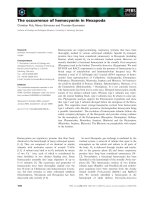
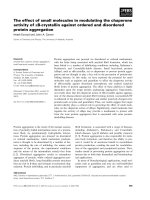
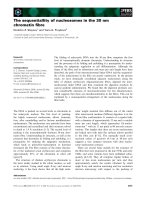
![Tài liệu Báo cáo khoa học: The stereochemistry of benzo[a]pyrene-2¢-deoxyguanosine adducts affects DNA methylation by SssI and HhaI DNA methyltransferases pptx](https://media.store123doc.com/images/document/14/br/gc/medium_Y97X8XlBli.jpg)
